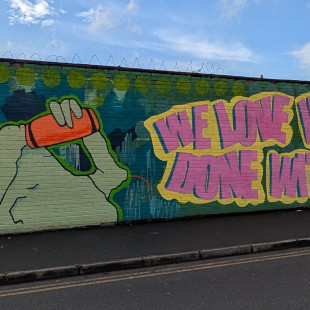Discovering the Whitby Heritage Trail

We recently spent a week away from Sheffield on the beautiful North Yorkshire coastline. We stayed just outside of the historic seaside town of Whitby.
Whitby is a popular town for tourism with its beach, abbey ruins and links to Bram Stoker’s Dracula. Sitting on the mouth of the River Esk, it has a strong maritime heritage with fishing still an important industry for the town. Whilst visiting, we were delighted to discover Whitby’s new sculpture trail celebrating this.
There are ten sculptures in the heritage trail, which can easily be discovered by foot as you walk around the town. Each sculpture was created by local artist Emma Stothard in partnership with Scarborough Borough Council. They are crafted from steel wire, and hand-woven around a steel armature then hot-dip galvanised.
The sculptures are well dispersed across Whitby. This makes it easy to stumble across them, whilst also encouraging people to explore the many areas of the town.
East Side

The first sculpture on the trail represents an ancient local custom held on the eve of Ascension Day. The annual ceremony of the Horngarth or the Planting of the Penny Hedge dates back to 1159. It is located on Church Street on the East Side, a little distance from the usual tourist trappings.

The bridgender sculpture represents a fishermen ready to share his knowledge, looking out for the weather to determine whether it is safe to sail out. This was the first sculpture we spotted and, like one other, incorporates a bench into the work that can be sat on.
West Side

Wives of fishermen would have had extremely long and busy days. Not only did they have to take care of the household, but would also work to support their husbands’ work. These women would need to prepare for baiting the long lines and sell the fish caught amongst many other jobs.

Net menders would have been a regular sight around the harbour. If the fishing nets were damaged, they needed mending before the boats went out again the next day. Otherwise, a day’s work, and therefore income, would be lost.

The fishermen’s wives would knit gansey sweaters for the men to protect them against the elements whilst out at sea. Apparently, each town and village would have had its own distinctive pattern. This would help identify where a fisherman was from should they become lost and then found injured at sea.

Frank Meadow Sutcliffe was a famous Victorian photographer from Whitby. His photographs of the local fishing community were exhibited world-wide and won many awards. This sculpture is not far from Botham’s of Whitby, an excellent traditional bakery shop, originally established in 1865.
West Cliff

Born in Cropton, 26 miles from Whitby, William Scoresby Jnr invented the Crow’s Nest. It enabled a ship’s navigator to work from the top of the main mast with some protection from the harsh weather conditions found at sea. This sculpture is positioned up at the top of the West Cliff looking out at the North Sea.

Dora Walker (1890-1980) is famous for being noted as the very first female fishing boat skipper on the North East coast. She was also an author and wrote about the town’s fishing community.
West Pier

The final stop on the trail is a pair of sculptures representing the herring lasses. From the early 1900s to World War II, these women would travel the East Coast to welcome the fishing fleets ready to gut and prepare the fish.

Closing Comments
The sculptures are truly beautiful, with great attention to detail. A lot of thought appears to have been given into the placement of each of them. The trail can easily be followed as a continuous 3km walk around the different parts of the town without having to backtrace the route. The Love Exploring app has a handy guide that starts with the Penny Hedge sculpture on the East Side and ends on the West Side with fish and chips on the pier. Of course, the trail can be tackled anyway you wish. We spotted the sculptures over the course of several days whilst visiting.
As well as discovering Whitby’s Heritage Trail, we also discovered several fantastic works of street art along the coastline. Check out our Instagram page for photos of murals from Scarborough to Staithes.
Leaving Whitby, we couldn’t help but think that a similar trail would work well in Sheffield. Steel sculptures celebrating our city’s industrial heritage sound fitting to us! We’re sure there are many stories about our city that should be remembered and celebrated. A permanent sculpture trail, like that in Whitby, would be a great way of doing this. It would also provide another incentive for people to visit Sheffield from further afield.





